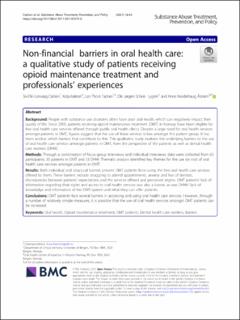| dc.contributor.author | Carlsen, Siv-Elin Leirvåg | |
| dc.contributor.author | Isaksen, Katja | |
| dc.contributor.author | Fadnes, Lars Thore | |
| dc.contributor.author | Lygren, Ole Jørgen Scheie | |
| dc.contributor.author | Åstrøm, Anne Nordrehaug | |
| dc.date.accessioned | 2022-01-24T11:48:19Z | |
| dc.date.available | 2022-01-24T11:48:19Z | |
| dc.date.created | 2021-07-12T13:57:24Z | |
| dc.date.issued | 2021 | |
| dc.identifier.issn | 1747-597X | |
| dc.identifier.uri | https://hdl.handle.net/11250/2838931 | |
| dc.description.abstract | Background
People with substance use disorders often have poor oral health, which can negatively impact their quality of life. Since 2005, patients receiving opioid maintenance treatment (OMT) in Norway have been eligible for free oral health care services offered through public oral health clinics. Despite a large need for oral health services amongst patients in OMT, figures suggest that the use of these services is low amongst this patient group. It has been unclear which barriers that contribute to this. This qualitative study explores the underlying barriers to the use of oral health care services amongst patients in OMT, from the perspective of the patients as well as dental health care workers (DHW).
Methods
Through a combination of focus group interviews and individual interviews, data were collected from 63 participants; 30 patients in OMT and 33 DHW. Thematic analysis identified key themes for the use (or not) of oral health care services amongst patients in OMT.
Results
Both individual and structural barriers prevent OMT patients from using the free oral health care services offered to them. These barriers include struggling to attend appointments, anxiety and fear of dentists, discrepancies between patients’ expectations and the services offered and perceived stigma. OMT patients’ lack of information regarding their rights and access to oral health services was also a barrier, as was DHWs’ lack of knowledge and information of the OMT system and what they can offer patients.
Conclusions
OMT patients face several barriers in accessing and using oral health care services. However, through a number of relatively simple measures, it is possible that the use of oral health services amongst OMT patients can be increased. | en_US |
| dc.language.iso | eng | en_US |
| dc.publisher | BMC | en_US |
| dc.rights | Navngivelse 4.0 Internasjonal | * |
| dc.rights.uri | http://creativecommons.org/licenses/by/4.0/deed.no | * |
| dc.title | Non-financial barriers in oral health care: a qualitative study of patients receiving opioid maintenance treatment and professionals’ experiences | en_US |
| dc.type | Journal article | en_US |
| dc.type | Peer reviewed | en_US |
| dc.description.version | publishedVersion | en_US |
| dc.rights.holder | Copyright 2021 The Author(s) | en_US |
| dc.source.articlenumber | 44 | en_US |
| cristin.ispublished | true | |
| cristin.fulltext | original | |
| cristin.fulltext | original | |
| cristin.qualitycode | 1 | |
| dc.identifier.doi | 10.1186/s13011-021-00379-6 | |
| dc.identifier.cristin | 1921513 | |
| dc.source.journal | Substance Abuse Treatment, Prevention, and Policy | en_US |
| dc.identifier.citation | Substance Abuse Treatment, Prevention, and Policy. 2021, 16, 44. | en_US |
| dc.source.volume | 16 | en_US |

